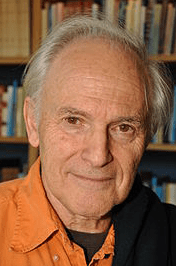Distinguished Speaker Series welcomes Sir Harold Kroto
The College of Sciences welcomes Sir Harold Kroto to UCF as a presenter in our Distinguished Speaker Series. Professor Kroto will give a lecture titled “Carbon in Nano and Outer Space” on Friday, March 30th, 2012 in the Communication Building, Room 101 starting at 4:30 PM.
Sir Harold Kroto is the 1996 Chemistry Nobel Laureate and the Francis Eppes Professor of Chemistry at Florida State University.
The abstract for his speech is below. 
The age-old awe that man has had for the heavens has driven almost all aspects of human culture and knowledge and resulted in technologies with generally positive, though occasionally negative effect. In fact it was only in the 16th Century when mankind finally applied the new doubt-based evidence-dependent analytical method, that is the metric then known as Natural Philosophy, to the motions of the planets that Science was born. From that moment we started to rely more on Science and an understanding of why things worked the way they do than on the “Common Sense” which is generally all that is needed to survive. This change occurred when Galileo used his telescope and realised that the phases of Venus provided the incontrovertible evidence which confirmed the Copernican heliocentric system and this cemented his position as one of, if not the, “Father of Science”. Thus Science itself was born out of curiosity, not out of expedience and is still true today that almost all major breakthroughs are made by the openly curious who generally discover what those with more focused minds tend to overlook.
With the development of radiotelescopes during the last half of the 20th Century, the very cold interstellar medium was found to be a veritable Pandora’s Box, full to the brim with fascinating and exotic molecules, dust particles as well as some highly puzzling material responsible for some as yet unidentified optical features. Particularly fascinating, curious and crucial has been the role that the element carbon has played in almost every aspect of the development of our understanding of both the physical and natural sciences. The fact that the element is at all abundant is due to a curious set of coincidences involving its nucleosynthesis from helium in stars. If one furthermore adds into the overall carbon equation its uniquely profuse chemistry, ie Organic Chemistry which is also the basis of biology, it is hard to conceive that life could be based on any other element. The most recent big surprise that the element had up its sleeve was the existence of C60, Buckminsterfullerene, the third well-defined form of carbon – the other two being graphite and diamond. The discovery of this molecule and its siblings (the whole family now known as the Fullerenes) was made serendipitously during laboratory experiments which attempted to explain the chemical synthesis of some unexpectedly long linear carbon chain molecules which we detected in the interstellar medium. Follow up work from the C60 discovery also led to the re-discovery of the carbon nanotubes which promise paradigm shifting advances in materials engineering.
The fact that this third, well-defined, form of carbon had been hiding in the shadowy corners of the Universe since time immemorial brings to mind the mysterious character lurking in the dark streets of Vienna, made famous by Orson Welles in the classic movie “The Third Man”. Especially compelling support for the idea that C60 existed in space lay in the fact that the original discovery was made serendipitously during laboratory experiments designed to simulate the atmospheric conditions in cool red giant carbon stars. This conjecture was confirmed in 2010 by tell-tale signatures found in infra red spectra obtained by NASA’s Spitzer satellite telescope.
This is yet another example of the remarkable way in which the fascination with space has catalysed fundamental breakthroughs in general science with major implications for innovative technological applications on Earth. In these difficult times this account provides evidence which supports the vital role that fundamental cross-disciplinary research has played in the past and will continue to play in the future in providing totally unpredictable advances of major strategic importance. It is rather important to consider the fact that although there are scores of applied science laboratories around the world focused on combustion processes and many thousands of papers purporting to explain the process this key species evaded them.
There is food for thought in the fact that C60 is now being made commercially by a relatively simple combustion technique and yet when it was first proposed that it might play some role in combustion the most fierce antagonism to this proposal came from some members of the combustion research community. The history of scientific progress carries a serious health warning for those who think that fundamental science can be steered by bureaucratic decision-making and the story of the discovery of the third form a carbon and its key role in the birth of Nanoscience and Nanotechnology is yet another example.
